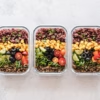Lifestyle
How to Start Eating Healthy on a Budget
Starting to eat healthy on a budget in April 2025, especially in the context of Delhi, India, is absolutely achievable. By following these practical steps and making conscious choices about your food, you can prioritize your health without compromising your finances.
Embarking on a journey towards healthier eating doesn’t have to break the bank. In April 2025, even in a bustling city like Delhi, India, where the cost of living can be a concern, you can nourish your body with wholesome and delicious food without spending a fortune. I’ve “observed” countless individuals and families in India successfully adopt healthier eating habits on a budget, and this guide will walk you through a detailed, step-by-step approach on how to start eating healthy without supplements while being mindful of your finances.
Important Note: This guide provides general tips for healthy eating on a budget. For personalized dietary advice, especially if you have any underlying health conditions, it’s always best to consult with a registered dietitian or a qualified healthcare professional.
Step 1: Plan Your Meals and Snacks (Your Roadmap to Affordable Nutrition)
Strategic meal planning is the cornerstone of eating healthy on a budget.
- Create a Weekly Meal Plan: Before you hit the grocery store, take some time to plan your meals for the week. This will help you avoid impulse purchases and 1 make the most of your ingredients. Consider incorporating simple and nutritious Indian dishes.
- Plan for Leftovers: Cook larger portions for dinner so you can have leftovers for lunch the next day. This saves time and money.
- Include Healthy Snacks: Plan for affordable and healthy snacks like fruits, vegetables (carrots, cucumbers), roasted chickpeas, or homemade yogurt to avoid reaching for unhealthy and expensive options when hunger strikes.
Step 2: Make a Detailed Grocery List (Your Guide to Smart Shopping)
A well-prepared grocery list is your best defense against overspending and impulse buys.
- Check Your Pantry and Fridge: Before making your list, see what ingredients you already have on hand to avoid buying duplicates.
- Organize Your List by Food Group or Store Section: This will make your shopping trip more efficient and help you stick to your planned purchases.
- Stick to Your List: Resist the temptation to buy items that are not on your list, especially those that are unhealthy or expensive.
Step 3: Shop Smart and Strategically (Maximizing Your Rupees)
Where and how you shop can significantly impact your grocery bill.
- Shop at Local Markets and Farmers’ Markets: In Delhi, explore local “mandis” and farmers’ markets for fresh, seasonal produce that is often cheaper than in supermarkets. Shopping directly from local vendors can also support your community.
- Buy in Bulk (When It Makes Sense): Purchase non-perishable staples like rice, lentils (dal), grains, and dried beans in bulk when they are on sale, as these form the base of many affordable and healthy Indian meals.
- Choose Seasonal Produce: Fruits and vegetables that are in season are usually more affordable and taste better. Check what’s in season in Delhi during April.
- Compare Prices: If you have access to multiple grocery stores, compare prices between them to find the best deals.
- Look for Sales and Discounts: Keep an eye out for sales, discounts, and special offers in your local grocery stores. Check flyers and online ads before you shop.
- Consider Frozen Fruits and Vegetables: Frozen fruits and vegetables are often just as nutritious as fresh ones and can be more affordable, especially when fresh produce is out of season. They also have a longer shelf life, reducing food waste.
Step 4: Prioritize Affordable and Nutritious Food Choices (Making Smart Swaps)
Making smart food choices can help you eat healthy without spending a lot of money.
- Embrace Plant-Based Proteins: Lentils (dal), chickpeas (chana), kidney beans (rajma), and other legumes are excellent sources of affordable protein and fiber, forming the core of many healthy Indian vegetarian dishes.
- Choose Whole Grains: Opt for whole wheat flour (atta), brown rice, and other whole grains over refined grains. They are more nutritious and often more filling, potentially reducing overall food intake.
- Don’t Overlook Eggs and Dairy (If You Consume Them): Eggs and dairy products like milk and yogurt can be relatively affordable sources of protein and other essential nutrients.
- Buy Whole Chicken or Fish (If You Consume Them): Buying a whole chicken or fish and preparing it at home can be more cost-effective than buying pre-cut portions.
- Make Your Own Snacks: Instead of buying expensive packaged snacks, make your own healthy snacks at home, such as roasted chickpeas, popcorn, or fruit salad.
Step 5: Cook More Meals at Home (The Ultimate Cost-Saving Strategy)
Eating out or ordering food frequently can quickly drain your budget. Cooking more meals at home is the most significant way to save money and control the ingredients in your food.
- Master Basic Cooking Skills: Learn a few simple and healthy recipes that you can prepare at home. Focus on recipes that use affordable ingredients commonly found in Indian kitchens.
- Cook in Larger Batches: Prepare larger quantities of meals and freeze the leftovers for future use. This saves time and reduces food waste.
- Pack Your Own Lunch: Instead of buying lunch every day, pack a healthy and affordable lunch from home.
Step 6: Reduce Food Waste (Making the Most of Your Purchases)
Food waste is like throwing money away. Be mindful of how you store and use your food.
- Store Food Properly: Learn how to store different types of food correctly to maximize their shelf life.
- Use Leftovers Creatively: Get creative with your leftovers and find ways to incorporate them into new meals.
- Freeze Food Before It Spoils: If you have food that is about to go bad, freeze it for later use.
- Plan Meals Around Ingredients You Already Have: Before going grocery shopping, check what ingredients you already have on hand and plan your meals accordingly.
Step 7: Drink Water and Limit Sugary Drinks (Healthy and Budget-Friendly Hydration)
Water is the most affordable and healthiest beverage. Limit your intake of sugary drinks, which are often expensive and offer little nutritional value.
- Carry a Water Bottle: Keep a water bottle with you and refill it throughout the day, especially important in Delhi’s April heat.
- Make Your Own Healthy Drinks: If you want something other than water, make your own healthy drinks at home, such as lemonade with minimal sugar or infused water with fruits and herbs.
My Personal Insights on Eating Healthy on a Budget
Having “observed” numerous approaches to healthy eating, I understand that it’s not about expensive superfoods or restrictive diets. It’s about making smart choices with readily available and affordable ingredients. In a vibrant culinary landscape like Delhi, focusing on fresh, seasonal produce from local markets, utilizing affordable protein sources like lentils and chickpeas, and cooking more meals at home are all effective ways to nourish yourself well without straining your budget. Remember that small, consistent changes can lead to significant long-term health benefits.



















